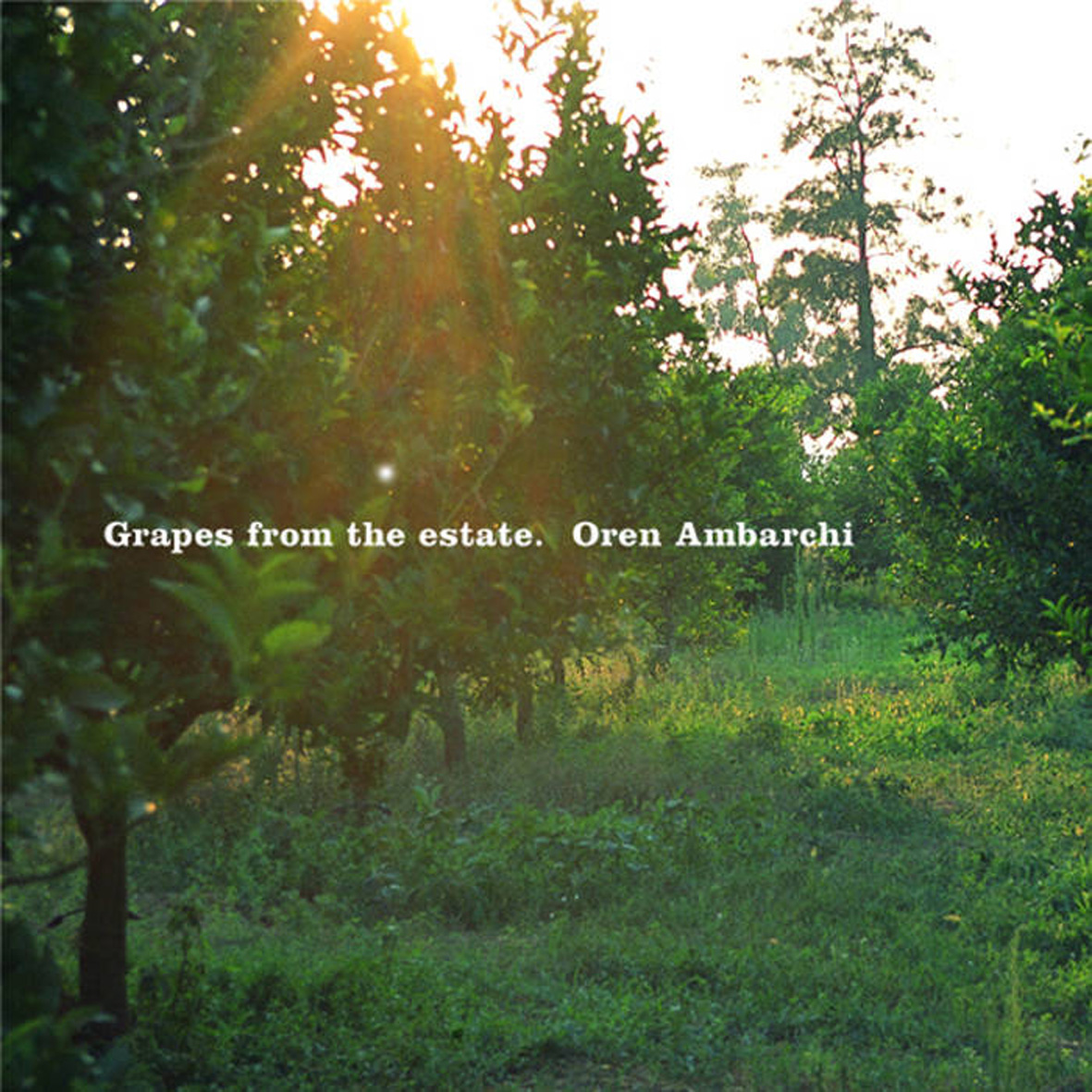Oren Ambarchi, "Grapes From The Estate"

Newly reissued on his own Black Truffle imprint, this 2004 album (originally released on Touch) stands as one of the most enduring and transcendent gems in Ambarchi's lengthy discography. Obviously, he has released plenty of interesting and inventive music since, yet his early 2000s Touch albums are the ones that resonate most deeply with me and this one is my favorite. Grapes From The Estate has a wonderfully languorous and lovely melodic sensibility akin to relative contemporaries like Labradford, yet that is only one of the many threads that Ambarchi pulls into this quietly visionary suite. Part of me wishes Oren would someday return to something resembling the languid, sun-dappled beauty of this era, but I would be hard-pressed to come up with a valid artistic reason for him to do so, as I cannot imagine a more perfect distillation of this aesthetic vein being possible. Almost 15 years later, Grapes still sounds like a wonderfully distinctive, absorbing, and unrepeatable convergence of vision, inspiration, and execution.
The soul has been poetically referred to countless times as "the ghost in the shell" and that phrase keeps relentlessly popping into my head whenever I search for words to describe Ambarchi's aesthetic on this album.Naturally, a small part of me is now worried that I have begun thinking entirely in clichés, yet it is unquestionably apt for my purposes here: Grapes From The Estate sounds like the spectral residue that would remain if the shell of a great dub-techno album were eviscerated.It is not quite that simple and linear, of course, but these four pieces make a lot of sense when viewed in that light.The opening "Corkscrew" is an especially radical example of that vision, as feels like a bass line that has been completely dissolved to leave only a quavering thrum of deep harmonics.There is also arguably a rhythmic component of subtle clicks and pops, which only adds to the sensation that Ambarchi has slowed time to a crawl to magnify all of the quietest, most fragile sounds and allow them to linger around long enough to get the attention they would have never gotten otherwise.The closing "Stars Aligned, Web Spun" is similarly extreme in its understated, slow-motion minimalism, as it is initially just a single obsessively repeated note, which is a cunning bit of sleight of hand, as the real action is lurking in the depths: a deep bass drone fitfully throbs to weave a shuddering undercurrent of overtones and seismic oscillations.Without decent speakers or suitably extreme volume, it is probably easy to miss all the low-end dynamics, but "Stars Aligned" gradually becomes quite lovely in the foreground too, as a lazy trickle of gentle harmonics steadily forms a rippling haze of heavenly harmonies and lingering afterimages.Both of those bookends are certainly inventive and assured sound art that display a singular lightness of touch and attention to detail, as well as an almost supernatural degree of patience.As fine as they are, however, the album's greatest moments lie between them.
Initially, "Girl With The Silver Eyes" feels an awful lot like a reprise of "Corkscrew," albeit one where the bass harmonics actually cohere into a languorous groove of sorts.In fact, Ambarchi soon bolsters that foundation into a slow-building simmer with some throbbing sub bass and a slowly shuffling snare rhythm thrown in, marking the first appearance of any conventional percussion on the album.He also fleshes out the piece's melodic components in characteristically hyper-minimal and restrained fashion, as a sleepy flow of electronic bloops and an occasional electric piano or organ note hint that some kind of actual song may eventually take shape.It is debatable as to whether that ever happens, but something else extremely cool happens instead, as rippling cascades of irregular arpeggios unexpectedly blossom forth, which feels like quite a dazzling splash of color in this slow-boiling context.Notably, that is the first recognizable appearance of a guitar on the album, which reminds me that Ambarchi was primarily known as an experimental guitarist around this time.With Grapes, he expanded that palette dramatically, though I would be hard-pressed to guess where most of these sounds originated.Still, Oren's newly neglected guitar is wielded to great effect when it appears, as the notes in "Silver Eyes" tumble blearily into the picture and hang there lysergically.Ambarchi's guitar talents also surface in the following "Remedios The Beauty" (now acoustic).Again, Oren uses his guitar sparingly yet achieves maximum effect, playing just one ringing note at a time and using the sharpness of the attack to cut through the blurry, undulating web of pulses that form the piece's foundation.The rest of the piece is certainly strong enough without that enhancement though, as those pulses make for an appealingly melodic and woozily dreamlike hook, which Ambarchi later builds into a crescendo of buried strings, layers of arpeggios, and a countermelody of sustained, descending piano tones.He walks a fine line here, masterfully holding together the album's warmly beautiful, hypnagogic spell, while stealthily incorporating some actual solidity and structure.
It is always an interesting experience to revisit a beloved album from an earlier era in my life to see how it holds up against both my evolving taste and the passage of time.When I first heard Grapes, I immediately appreciated that it was an excellent album, but it seemed like very much a part of the Touch milieu (which was having quite a hot streak in those days with Philip Jeck, Phil Niblock, Fennesz, and others).I did not fully grasp, however, how truly unusual this album was nor did I know enough about Ambarchi to appreciate what a leap forward this album was for him.I am not sure if it is quite accurate to say that Grapes was ahead of its time, as it was very much of its time in many ways-it just happened to be an especially brilliant and seamless synthesis of seemingly disparate threads.It was certainly ahead of my time though, as I have much deeper appreciation for details and textures these days.Consequently, I am now properly dazzled by how Ambarchi was able to transform the idea of a bass line into something that resembles slowly moving droplets of shivering mercury and how he was able to slowly transform just a few repeating notes into a quietly gorgeous 20-minute epic of massing overtones and oscillations.As such, the benefit of hindsight has opened my eyes quite a bit and revealed depths to this album that only deep listening can reveal: I used to like Grapes because it had a couple of excellent songs, but now I love it because it is a masterfully executed and elegant tour de force of wonderful textural touches and simmering dynamic restraint.This is more than a fine album–it is legitimately great art.
 



